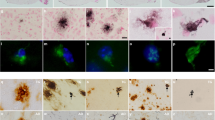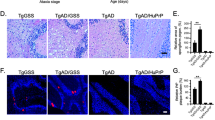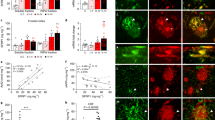Abstract
Abnormal and excessive accumulation of the amyloid β–peptide (Aβ) in the brain is a major and common characteristic of all Alzheimer's disease (AD) forms irrespective of their genetic background. Insoluble aggregates of Aβ are identified as amyloid plaques. These deposits are thought to form when the amount of Aβ is increased in the brain parenchyma as a result of either overexpression or altered processing of the amyloid precursor protein (APP)1–3. Soluble Aβ ending at carboxyl–terminal residue 40 (Aβ40) and, in lesser amount, the form ending at residue 42 (Aβ42), are normal products of the APP metabolism in cell cultures. Increased secretion of soluble Aβ42 has been observed in cells transfected with constructs modeling APP gene mutations of familial forms of AD (refs 4, 5). On the basis of these in vitro data it has been hypothesized that the presence of soluble Aβ42 plays a role in the formation of amyloid plaques. Subjects affected by Down's syndrome (DS) have an increased APP gene dosage and overexpress APP. Apparently because of this overexpression, they almost invariably develop amyloid deposits after the age of 30 years, although they are free of them at earlier ages6,7. Moreover, it has been observed that Aβ42 precedes Aβ40 in the course of amyloid deposition in DS brain8. Thus, DS subjects provide the opportunity to investigate in the human brain the metabolic conditions that precede the formation of the amyloid deposits. Here we report that soluble Aβ42 is present in the brains of DS–affected subjects aged from 21 gestational weeks to 61 years but it is undetectable in age–matched controls. It is argued that overexpression of APP leads specifically to Aβ42 increase and that the presence of the soluble Aβ42 is causally related to plaque formation in DS and, likely, in AD brains.
This is a preview of subscription content, access via your institution
Access options
Subscribe to this journal
Receive 12 print issues and online access
$209.00 per year
only $17.42 per issue
Buy this article
- Purchase on Springer Link
- Instant access to full article PDF
Prices may be subject to local taxes which are calculated during checkout
Similar content being viewed by others
References
Selkoe, D.J. Cell biology of the amyloid b-protein precursor and the mechanism of Alzheimer's disease. Anna. Rev. Cell Biol. 10, 373–403 (1994).
Selkoe, D.J. Normal and abnormal biology of the b-amyloid precursor protein. Anna. Rev. Neurosci. 17, 489–517 (1994).
Cai, X.-D., Golde, T.E. & Younkin, S.G. Release of excess amyloid β protein from a mutant amyloid b protein precursor. Science 259, 514–516 (1993).
Citron, M. et al. Mutation of the β-amyloid precursor protein in familial Alzheimer's disease increases b-protein production. Nature 360, 672–674 (1992).
Suzuki, N. et al. An increased percentage of long amyloid b protein secreted by familial amyloid β protein precursor (βAPP717) mutants. Science 264, 1336–1340 (1994).
Wisniewski, K.E., Wisniewski, H.M. & Wen, G.Y. Occurrence of neuropathological changes and dementia of Alzheimer's disease in Down's syndrome. Ann. Neural. 17, 278–282 (1985).
Mann, D.M.A., Yuonis, N., Jones, D. & Stoddart, R.W. The time course of pathological events in Down's syndrome with particular reference to the involvement of microglial cells and deposits of β/A4. Neurodegeneration 1, 201–215 (1992).
Iwatsubo, T., Mann, D.M.A., Odaka, A., Suzuki, N. & Ihara, Y. Amyloid b protein (Aβ) deposition: Aβ42 (43) precedes Aβ40 in Down syndrome. Ann. Neural. 37, 294–299 (1995).
Tamaoka, A. et al. Biochemical evidence for the long-tail form (Aβl-42/43) of amyloid β protein as a seed molecule in cerebral deposits of Alzheimer's disease. Biochem. Biophys. Res. Commun. 205, 834–842 (1994).
Tabaton, M. et al. Soluble amyloid β-protein is a marker of Alzheimer amyloid in brain but not in cerebrospinal fluid. Biochem. Biophys. Res. Commun. 200, 1598–1603 (1994).
Roberts, G.W., Gentleman, S.M., Lynch, A. & Graham, D.I. Beta A4 amyloid protein deposition in brain after head trauma. Lancet II, 1422–1423 (1991).
Asami-Odaka, A., Ishibashi, Y., Kikuchi, T., Kitada, C. & Suzuki, N. Long amyloid β-protein secreted from wild-type human neuroblastoma IMR-32 cells. Biochemistry 34, 10272–10278 (1995).
Rumble, B. et al. Amyloid A4 protein and its precursor in Down's syndrome and Alzheimer's disease. N. Engl. J. Med. 320, 1446–1452 (1989).
Hilbich, C. et al. Aggregation and secondary structure of synthetic amyloid beta A4 peptides of Alzheimer's disease. J. Mol. Biol. 218, 149–163 (1991).
Gravina, S.A. et al. Amyloid b protein (Aβ) in Alzheimer's disease brain: Biochemical and immunocytochemical analysis with antibodies specific for forms at Aβ40 or Aβ42 (43). J. Biol. Chem. 270, 7013–7016 (1995).
Tamaoka, A. et al. Amyloid b protein 1–42/43 (Aβ 1–42/43) in cerebellar diffuse plaques: Enzyme-linked immunosorbent assay and immunocytochemical study. Brain Res. 679, 151–156 (1995).
Yamaguchi, H., Sugihara, S., Ishiguro, K., Takashima, A. & Hirai, S. Immunohistochemical analysis of COOH-termini of amyloid beta protein (Ab) using end-specific antisera for Aβ40 and Aβ42 in Alzheimer's disease and normal aging. Amyloid: Int. J. Exp. Clin. Invest. 2, 7–16 (1995).
Wenham, P.R., Price, W.H. & Blundell, G. Apolipoprotein E genotyping by one-stage PCR. lancet 337, 1158–1159 (1991).
Schägger, H. & von Jagow, G. Tricine-sodium dodecyl sulfate-polyacrylamide gel electrophoresis for the separation of proteins in the range from 1 to 100 kDa. Anal. Biochem. 166, 368–379 (1987).
Kim, K.S. et al. Detection and quantification of amyloid b-peptide with 2 monoclonal antibodies. Neurosci. Res. Commun. 7, 113–122 (1990).
Kim, K.S. et al. Production and characterization of monoclonal antibodies reactive to synthetic cerebrovascular amyloid peptide. Neurosci. Res. Commun. 2, 121–130 (1988).
Sternberger, L.A. Immunocytochemistry (Wiley, New York, 1979).
Chomczynski, P. & Sacchi, N. Single-step method of RNA isolation by acid guanidinium thiocyanate-phenol-chloroform extraction. Anal. Biochem. 162, 156–159 (1987).
Author information
Authors and Affiliations
Rights and permissions
About this article
Cite this article
Teller, J., Russo, C., Debusk, L. et al. Presence of soluble amyloid β–peptide precedes amyloid plaque formation in Down's syndrome. Nat Med 2, 93–95 (1996). https://doi.org/10.1038/nm0196-93
Received:
Accepted:
Issue Date:
DOI: https://doi.org/10.1038/nm0196-93



